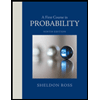
A First Course in Probability (10th Edition)
10th Edition
ISBN: 9780134753119
Author: Sheldon Ross
Publisher: PEARSON
expand_more
expand_more
format_list_bulleted
Question
Let X be a discrete random variable with PMF Px(X) = { (0.5, x=2) (0.3, x=5) (0.2, x=6) (0, otherwise)
a. Find, and graph, the CDF for this random variable.
b. Find the expected value , EX .
c. Find the variance, Var(X ).
d. Let y = 5/x Find the expected value EY.
Expert Solution
This question has been solved!
Explore an expertly crafted, step-by-step solution for a thorough understanding of key concepts.
Step by stepSolved in 3 steps with 1 images

Knowledge Booster
Similar questions
- Let Y, represent the ith normal population with unknown mean #, and unknown variance of for i=1,2. Consider independent random samples, Ya, Ya, Yin, of size n,, from the ith population with sample mean Y, and sample variance S² = (₁-P) ². (d) Define V₁, a function of S1, that has a chi-square distribution. (e) Is V₁ a pivotal function to find a confidence interval for o?? Explain with argument. (f) Find a (1-a) x 100% confidence interval for ofarrow_forwardA random variable X takes value 1 with probability and the value 2 with the remaining probability. What is the variance of X, Var[X]? O 1/3 3/4 2/3 1/2 O 1/4arrow_forwardWith an American penny, the likelihood of getting H when it is spun on edge is 0.3. If X is the random variable where X(H ) = 1, X(T ) = −1, find the expected value E(X), the variance, Var(X), and express X in its standard form.arrow_forward
- In a poisson distribution P(X=0) = P(X=2).Find the variance V(X) of X.arrow_forward1. Let X be a random variable with pdf f(x) = 1,0 3).arrow_forwardTrying to find variance. his equation is Prob(x)*[x-e(x)]^2. Just need an example to get me started.Original question is: A call center recieves an average of 10 calls per hour. Assuming the number of calls received follows the poisson distribution, determine the probability of each of the discrete outcomes below. Then calculate the variance component for each one using the standard formula for the variance of a discrete random variable. At the end, take the sum of both columns. Table: Poisson Distribution Table Calls Density Variance 0 0.00% 1 0.05% 2 0.23% 3 0.76% 4 1.89% 5 3.78% 6 6.31% 7 9.01% 8 11.26% 9 12.51% 10 12.51% 11 11.37% 12 9.48% 13 7.29% 14 5.21% 15 3.47% 16 2.17% 17 1.28% 18 0.71% 19 0.37% 20 0.19% 21 0.09% 22 0.04% 23 0.02% 24 0.01% 25 0.00% 26 0.00% 27 0.00% 28 0.00% 29 0.00% 30 0.00% Sum 100.00%arrow_forward
- The random variable X takes value O with probability, and value 1 with the remaining probability. The random variable Y takes value 100 with probability and value 101 with the remaining probability. What is the relation between the variance of X and the variance of Y? Var[X] Var[Y] "arrow_forwardLet X be a normal random variable with mean 85 and a variance of 25 (i.e., X ∼ N (85, 25)). step1: Let M = aX + b for some constants a, b not equal to 0. Write an expression for the pdf of M . step 2: Suppose that X represents an approximate distribution of the final scores in a certain math course (ignore the fact that this approximation can technically have scores that are greater than 100 or less than 0). If the teacher were to curve the scores, it means he would determine a function to apply to the scores to achieve a desired distribution (assume an affine function in this case, as in the previous part). Suppose he wants the scores to be normally distributed with mean 80 and a standard deviation of 4. What should he choose for a and b? What students would see their score lowered, and what students would see their score increased?arrow_forwardLet x1, x2, ..., n represent a random sample from a distribution with mean E(x) and variance Var(x). Show that Cov(x, x₁ - x) = 0.arrow_forward
- How do you find the mean and variance of part(d)?I need the detailed solution.arrow_forward'Melanoma' is a form of skin cancer and each year 17% of the patients who suffer from the disease die. A random sample of 10,000 melanoma patients is formed at the start of a year. Let Y denote the number of patients in this sample who will die during the year? (a) What is the expected value of Y? That is, compute E(Y). Answer: [Select] (b) What is the variance of Y? That is, compute var(Y). Answer: [Select] (c) What is the probability that Y exceeds 1,800? That is, compute P(Y> 1,800). Answer: [Select]arrow_forward
arrow_back_ios
arrow_forward_ios
Recommended textbooks for you
 A First Course in Probability (10th Edition)ProbabilityISBN:9780134753119Author:Sheldon RossPublisher:PEARSON
A First Course in Probability (10th Edition)ProbabilityISBN:9780134753119Author:Sheldon RossPublisher:PEARSON

A First Course in Probability (10th Edition)
Probability
ISBN:9780134753119
Author:Sheldon Ross
Publisher:PEARSON
